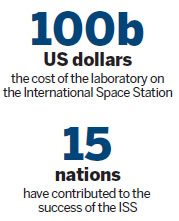Spacewalking cosmonauts launch satellite
A pair of Russian cosmonauts began their workweek on Monday, floating outside the International Space Station to toss out a small satellite for a university in Peru, installing science experiments, and tackling some housekeeping chores.
First out of the hatch was cosmonaut Oleg Artemyev, who stood on a ladder outside the station's Pirs airlock to release a 1-kg, 10-cm cube-shaped satellite built by students at the National University of Engineering in Lima, Peru.
Video broadcast on NASA Television showed the satellite, Chasqui-1, tumbling away from the back of the station as it sailed 418 km above the southern Pacific Ocean.
The solar-powered spacecraft, whose name means "messenger" in the Quechua language of the Incas, is outfitted with visible light and infrared cameras to take pictures of Earth and sensors to measure temperature and pressure as it orbits.

Artemyev was then joined by spacewalker Alexander Skvortsov to install a European package of experiments to the outside of the Russian Zvezda module. The experiments include biomaterials and extremophiles, which are organisms that can live in extremely hostile environments.
Scientists hope to use information about how the organisms fare in the highly radioactive and extreme temperatures of space to devise life-detection techniques for future robotic Mars missions.
The cosmonauts also installed a reinforcing clamp for a communications antenna they attached during their last spacewalk in June. Monday's to-do list included taking samples of residue on the outside of some of Zvezda's windows and setting up an experiment to measure how plumes from rocket-engine burns may be affecting parts of the station.
Artemyev and Skvortsov breezed through their planned six-hour spacewalk, which began shortly after 10 am EDT (10 pm China time), and were back inside the station's airlock 45 minutes early.
Artemyev, Skvortsov and NASA station commander Steve Swanson are five months into a planned six-month mission. Also aboard the complex are NASA astronaut Reid Wiseman, European astronaut Alexander Gerst and Russian cosmonaut Maxim Suraev, who arrived on May 28.
The station, a $100 billion research laboratory for materials and life science experiments, technology demonstrations and other microgravity research, is a partnership of 15 nations that has been occupied by rotating crews of astronauts and cosmonauts since November 2000.
Reuters
(China Daily 08/20/2014 page10)


















